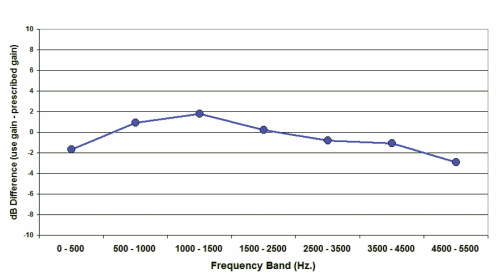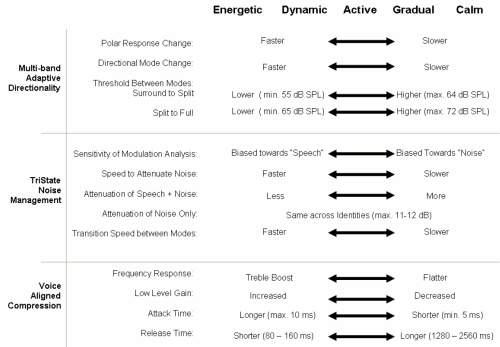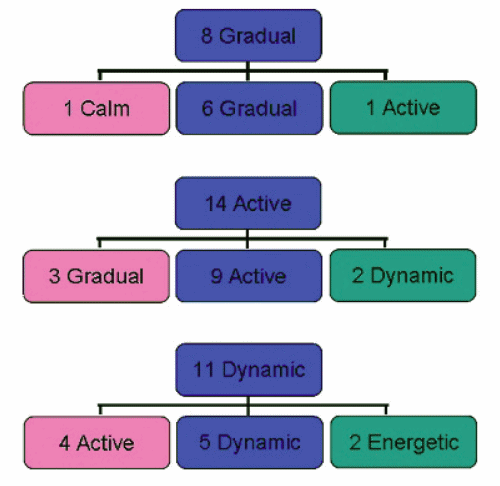One of the goals of an effective hearing aid fitting is to package the world of sound into the remaining hearing capability of the patient. From the patient's perspective, a successfully amplified soundscape must provide sufficient benefit and comfortable intelligibility for a multitude of speech and other desirable sounds, while not negatively impacting the patient's personal sound experience.
With the advent of programmable and digital technologies, vast new dimensions of device performance have become available to the professional. With just a handful of independent technical dimensions, thousands of permutations are possible. In this regard, one could argue technology has outpaced our understanding of the outcomes and interactions of multiple, independent technical manipulations. In fact, little is known regarding the perceptual consequences of dynamic changes along multiple dimensions, and/or the concomitant interaction between dimensions.
As a manufacturer of advanced technology amplification, it is our responsibility to provide guidance regarding the outcome and interaction of programming changes made on advanced technology dimensions. Through our proprietary hearing aid fitting software ("Genie") we avail integrated, engineered and intelligent master adjustment handles, referred to as "Meta Controls." Because patients tend to have global, qualitative descriptors for device performance ( for example; too loud, too quiet, too tinny etc.) when properly engineered and implemented, Meta Controls should effectively address these same concerns from patients.
I. Adaptation Manager:
In 1997, we introduced our first Meta Control in the DigiFocus product line; the Adaptation Manager. The fitting rationale for DigiFocus was a unique protocol called Adaptive Speech Alignment (ASA). ASA was developed with a keen appreciation for loudness perception associated with sensorineural hearing loss (Schum, 1996). Nonetheless, many first time users requested a reduction in loudness or "less sharpness" when initially fit. To address the immediate perceptual experience of first-time users, as well as the long-range need for appropriate audibility, we created the Meta Control called the "Adaptation Manager."
The Adaptation Manager provided gradual, intentional changes with respect to attack time, gain, compression ratios and frequency response. As the patient progressed from Step 1 to Step 3, gradual changes across parameters allowed the patient to adapt to amplified sound over several weeks, culminating in Step 3, which provided the fully prescribed settings for the product. Although most new users started with Step 1, experienced users sometimes started with Step 2, while others started with Step 3, depending on their amplification experience and needs.
Schum (1997) reported prior to implementation of the Adaptation Manager, nearly half (46%) of the new users fit with DigiFocus requested a decrease in amplification. Only 33% of the users accepted the prescribed settings at the first fitting.
Following implementation of the Adaptation Manager in advanced technology products, new users accepted the prescribed settings of the device more readily as they adapted at a slower, prescribed pace over the course of several weeks (Schum, 2001). Figure 1 (below) provides the average deviation from prescribed gain settings across the seven bands (of DigiFocus) some 6 weeks after being fit via the Adaptation Manager. Notice the average deviation is within 1 to 3 dB of the prescribed settings. These findings verified the accuracy of the ASA fitting rationale and confirmed the importance of fitting new users with Adaptation Manager.
Adaptation Manager is now a standard feature within our non-linear hearing aids, with the exception of our superpower BTEs (the need for the Adaptation Manager among adults with longstanding profound sensorineural hearing loss, and for newly identified profoundly hearing impaired children is essentially non-existent).
Recently, we introduced an automatic version of the Adaptation Manger within Oticon's Syncro 2. The professional can activate the traditional three-step Adaptation Manager, or he/she can select the automatic program. If the professional chooses the automatic program, he/she selects a time course across which the adaptation process occurs and the device automatically updates itself daily to implement the multiple steps within the process.
Figure 1. The difference between actual and prescribed settings for a group of new Digifocus users fit with the Adaptation Manager (adapted from Schum, 2001).
II. Identities:
Over the last few years, many effective automatic and adaptive features have been incorporated within digital signal processing (DSP) hearing aids. Noise reduction circuitry analyzes the incoming signal and provides comfort based attenuation without appreciable degradation of important speech sounds, to make the device more acceptable in noisy environments. Automatic adaptive directionality allows the device to analyze the acoustic landscape within the patient's environment and shift to an appropriate directional mode to improve the signal-to-noise ratio provided to the user.
When implementing adaptive features in advanced technology digital hearing aids, two approaches can be taken:
- The environmentally adaptive hearing aid can slowly and subtly adapt itself to changes in the acoustic environment. For example, as the sound characteristics change, the hearing aid realigns itself to be a more appropriate signal processor for that given acoustic environment, maximizing the signal-to-noise ratio, while assuring maximal sound quality and comfort.
- The environmentally adaptive hearing aid can aggressively adapt itself to changes in the acoustic environment. For example, as the sound characteristics change, directionality, noise reduction and compression are immediately altered to inundate the listener with as many potentially relevant speech cues as possible at each given moment in time.
Unfortunately, potential negative and unpredicted interactions (antagonistic effects) are possible as the professional adjusts characteristics of one or more individual subsystems. For example, if activation times of the noise management system are adjusted to be rapid, yet the compression system or adaptive directional system is set for a more gradual response -- there can be unexpected corruption of the signal. Therefore, we've created the concept of "Identities" (Oticon, 2004).
An Identity is a discrete group of chosen settings, from a broad range of potential device dimensions, designed to operate synergistically and appropriately to create a well defined overall sound processing strategy. Parameters which impact device performance and are addressed within the Identities protocols are:
- Speed of adaptation of polar plots.
- Speed of changing between directional modes.
- Speed of application of gain reductions by noise reduction systems.
- Amount of gain reduction in the in noise reduction modes.
- Amount of low-level gain.
- Frequency response.
- Compression attack and release time.
- Compression ratio.
When fitting or adjusting Syncro, the professional can select from five unique Identities; calm, gradual, active, dynamic and energetic. For Tego or Tego Pro, three Identity choices are available; gradual, active and dynamic. Each Identity represents a unique combination of parameters and settings.
When moving from one end of the Identities continuum to the other, the quantity and quality of changes vary dramatically. On one end of the continuum (for example "Calm"), the instrument will have a subtle and slowly adapting reaction to a change in the characteristics of the listening environment. On the other end of the continuum (for example "Energetic"), the instrument will have a rapid and more aggressive response to changes in the acoustic environment.
The concept of device Identity was developed to responsibly manage ever-increasing device complexity. As hearing instruments include more advanced signal processing strategies, combinations and options, we have an increased responsibility to make changes based on predictable, logical and repeatable synergistic changes. Some patients may prefer or perform better with a more aggressive approach, whereas others may prefer or perform better with a more subtle approach.
Some manufactures have developed unique hearing aid products with aggressive approaches to environmental change, while others provide a subtle, slowly adaptive systems. Unfortunately, the best match between parameters and candidates is often unpredictable. Therefore, we maintain that each individual requires alternatives to maximally meet their individual hearing aid amplification needs. Identities allow for the highest likelihood of a successful hearing aid fitting. Rather than pre-selecting an amplification approach that may (or may not) be the best choice for an individual patient, Identities allows a range of approaches, available in a single product, with quick, straightforward alternatives, available as needed.
Figure 2 is an overview of dimensions affected (in Syncro) via changes in Identities.
Figure 2. The effect on Syncro performance of changes in Identity
The Value of Individualization:
While fitting Syncro, one of the three middle Identities are prescribed to each patient based on a variety of demographic issues; age, hearing loss, etc. Flynn and Lunner (2004) report on 37 patients in a verification study of Syncro performance. Of those 37 patients, 33 completed further testing specifically designed to examine Identity options. The 33 participants were distributed across the three possible prescribed Identities: 11 were prescribed Dynamic, 14 were prescribed Active, and 8 were prescribed Gradual.
To determine accuracy of the Syncro Identity prescriptions, patients were allowed to adapt to their original prescribed identity. After that, they were given 2-3 weeks to use more aggressive and less aggressive Identities. Following exposure and experience with all three alternative Identities, they were asked to indicate their preference.
Figure 3. Distribution of patients based on their original Identity, and their "preferred" Identity.
Twenty of the 33 participants (61%) chose the prescribed Identity. Across the three prescribed starting Identities, there is an approximately even distribution for those choosing other options. These data (above) indicate three important aspects of an Identity-based prescription:
First, patients can distinguish between Identities. The data from these subjects and others indicates that 75 to 80% of patients can clearly hear differences between neighboring Identities and a change of "two identity steps" is clearly audible to all patients.
Second, the criteria we use to select the prescribed Identity appears to be accurate the majority of the time. When given two other options, patients chose the prescribed option 61% of the time.
Finally, a significant minority of patients chose an alternative Identity which was evenly distributed across alternatives, which justifies the need to be able to customize the product. The general accuracy of the prescription process is supported, but the need to quickly and efficiently offer alternatives is also indicated.
Identities for Severe & Profound Loss:
In many ways, the amplification needs for those with severe and profound hearing loss are fundamentally different than the needs of patients with lesser degrees of loss. For patients with the greatest amount of hearing loss, there are differences in how much audibility and compression should be used to best understand amplified speech. In contrast, patients with less hearing loss can usually handle a variety of different compression schemes reasonably well.
In our non-linear super power product, Sumo DM, we use Identities to vary the ways in which gain and compression are applied. At one end of the continuum, audibility is maximized through use of higher gain levels with emphasis in the mid and high frequencies, and with more and faster acting compression. This approach has been designed for patients with significant audibility loss, yet with good ability to resolve complex signals such as speech. On the other end of the continuum, Identities provides a signal with less compression for patients whose ability to resolve complex signals has been more significantly compromised.
Summary:
The need for Meta Controls within hearing instruments is predicated on options and outcomes available through advanced technology hearing aid amplification.
- Individual adaptation to amplification occurs at unique and unpredictable rates. The ability to automatically and/or individually address the needs of the patient within the adaptation arena is an important concept. In general, new patients are more likely to accept amplification if they can adapt gradually to their final prescription.
- The number of permutations and interactions within modern hearing aids is so vast, that it is beneficial to group together related technical controls to maintain predictable, repeatable and beneficial alternatives for each unique patient.
- Patients respond to overall qualitative sound characteristics of a hearing aid, more so than to specific circuit changes. Therefore, engineered, integrated changes which positively impact subjective observations, without negatively impacting acoustic perceptions, are a welcome option.
The Adaptation Manager allows hearing aid users to adapt to amplified sound gradually via an automatic or prescribed "ramp-up" time period. Identities allows multiple distinct "sound personalities" within a given advanced technology product. Combining the attributes of the Adaptation Manager with Identities allows maximal fitting flexibility, to best meet the acoustic needs of individual patients.
Please Note: An earlier version of this article was provided by Oticon to audiology graduate students as a special supplement to the Hearing Journal, February, 2006.
Works Cited:
Flynn, M. & Lunner, T. (2004). Clinical Evidence for the Benefits of Oticon Syncro. Oticon White Paper, September. Somerset, NJ: Oticon Inc.
Oticon (2004). The Syncro Handbook. Schum, D. (1997). Field evaluation of the Adaptive Speech Alignment fitting rationale. News from Oticon.
Schum, D. (1996). Adaptive Speech Alignment: A new fitting rationale made possible by DSP. The Hearing Journal, 49, 25-30.
Schum, D. (2001). Adaptation Management for Amplification. Seminars in Hearing, 22(2), 173-182.



